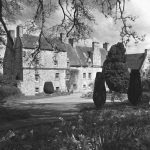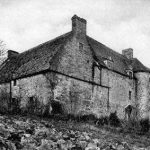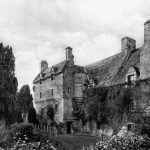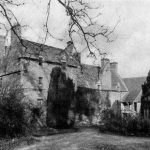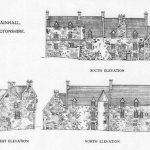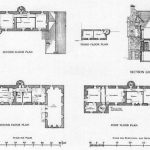Pringle of Woodhead (Fountainhall)
Pringle of Woodhead (Fountainhall)
Woodhead House, later called Fountainhall or somtimes Penkaet House.
In 1635 Robert Pringle of Templehalls purchased Woodhead House and its lands, from Sir George Cockburn of Ormiston, and an extension was built dated 1638 with John Pringle of Woodhead’s initials.
The name was changed after purchase in 1685 by Sir John Lauder of Newington (later Lord Fountainhall). He changed the name because as an advocate he didn’t like the sound of ‘Lord Woodhead’!
Fountainhall lies some 1½ (2½ km) miles SW of Pencaitland in East Lothian.
The lineage of the Pringles of Woodhead, Templehalls, Borgue, Soutra and Blackshiels
From Alex Pringle’s book ‘The Records of the Pringles of the Scottish Border’
- Robert Hoppringill, rector of Morham (brother of George Hoppringill of Torwoodlee), d. 1582.
- Robert Hoppringill, who predeceased his father.
- William Hoppringill in Milton d. 1635
- Robert Hoppringill of Templehalls and Woodhead, W.S., also laird of Whitburgh and Blackhouse.
- John Pringill of Woodhead, d. 1659.
- John Pringle of Woodhead
- Alexander Pringle
- Robert Pringle
- John Pringle
- David Pringle in Templehalls
- David Pringle, d. 1754
- David Pringle
- Andrew Pringle in Ballincrieff Mains
- Andrew Pringle of Borgue in Kirkcudbrightshire
- Andrew Pringle of Borgue and Lann Hall, M.D. d. 1858 in London.
- Andrew Pringle of Banstead, Surrey. d. 1893. Author of Practical Micro-Photography.
- Robert-Hunter Pringle, Asst. Commissioner of the Royal Commission of Agriculture.
- John-James Pringle, a Dermatologist at Middlesex Hospital, London. Died in New Zealand in 1922.
- Andrew Pringle of Borgue and Lann Hall, M.D. d. 1858 in London.
- John Pringle, W.S. and Deputy Clerk of Session
- Andrew Pringle of Borgue in Kirkcudbrightshire
- David Pringle, d. 1754
- John Pringle of Woodhead
- Robert Pringill of Dewar, W.S.
- John Pringill of Woodhead, d. 1659.
- John Pringill in Milton; laird of Soutra and Blackshiels (2nd son of William in Milton), d. 1650.
- William Pringill of Soutra
- Robert Pringill of Blackshiels (succeeded his brother to Soutra).
- Agnes Pringle, married David Pringle brother of John of Woodhead. d. 1686. – Their initials can be seen over the door of Soutra Aisle.
- Margaret Pringle
- Agnes Pringle, married David Pringle brother of John of Woodhead. d. 1686. – Their initials can be seen over the door of Soutra Aisle.
- John Pringill in Milton
- Lilias Pringle, married David Pringle in Templehalls (see above).
- George Pringill
- John Hoppringill, the younger, of Magray
- John Pringill
- William Hoppringill in West Pencaitland
- George Hoppringill in Magray
- James Hoppringill in East Spott Mill
- Robert Hoppringill of Templehalls and Woodhead, W.S., also laird of Whitburgh and Blackhouse.
- John Hoppringill
Note by James Bruce Pringle (brother of Sir Murray Pringle of Stichill):
William Hoppringill, first of Torwoodlee
William was killed at Flodden in 1513. His seven sons (George, James, David, Robert, William, Thomas and John) and daughter (Margaret) were subject to a notarial ratification on 19 April 1532. From this and other information, it is clear that most if not all William’s children were minors when their father died. The notary was William Stevenson, clerk, St. Andrew’s diocese. Witnesses were Mr James Lawson, Mr Robert Pringle, William Cairncross and sir Richard Lawson.
Note: Master Robert (rector of Morham) cannot be the same as Robert, brother of George. In Alex Pringle’s book (page 330), he states that in 1508 Robert Pringle, brother of George of Torwoodlee and Clifton, appears first as rector of Morham, Haddingtonshire (see East Teviotdale and for his marriage, Fountainhall.
James Lawson and sir Richard Lawson were obviously a relatives of the late William Hoppringill’s wife and William Cairncross was Marion Hoppringill’s husband – see below.
William of Westerhousebryes
On 10 September 1547, Hugh Ross, 10th of Kilravock, Nairn, was taken prisoner by John Carr of Wark. In October at Torwoodlee, Ross granted a bond to John Hoppringill of Smailholm, George of Torwoodlee and William of Westhousebyres (Torwoodlee’s brother), to repay to them the 100 angels they had advanced to him to pay his ransom.
In 1555, William is chosen with others to divide the goods belonging to Andrew Ker of Clarilaw, as second husband of the deceased Marion Hoppringill and those pertaining to her children by her previous husband the late William Cairncross of Colmslie.
In 1570, William acts as bailie at the sasine of John Hoppringill of Smailholm in a part of Mellerstain.
In 1572, William us summoned, with other kinsmen, by Thomas Hoppringill of that Ilk, now 14, to provide him with Tutors.
In 1582, William appears as Tutor to Marion Hoppringill grand-daughter of the late Robert Hoppringill of Ewingston [see Pentcaitland], brother of the late George of Torwoodlee.
In 1610, (?) Pringill, son of the late William of Westhousebrye, gets a gift of the nonentry, mails and duties of the 4th part of Clifton that pertained to William Pringle first of Torwoodlee, for all years that the same has been in the hands of the King, since the death of the said William at Flodden and for all years to come till the entry of the righteous heir (P.S. vol. 79).
Fountainhall, East Lothian
John Sinclair, who had a kindly tack of Ewingston, died in 1550, and Robert Hoppringill, brother german of George of Torwoodlee, married his widow Alison Harwood, promising in 1555, it was alleged, to vacate the tack when Sinclair, junior, came of age.
By his spouse, Robert had three sons – Robert, William and John – and three daughters. Robert, the eldest son, who predeceased his father in 1579, left by his spouse, Margaret Ker, a daughter Marion, whose curator was William Hoppringill of Westhousebyer.
Robert and his second son William moved further down the valley into the neighbouring farm of Milton; and here, according to his testament, Robert died in 1582.
William Pringill in Milton, who died in 1637, had by his spouse Elizabeth Baptie: (1) Robert of Templehalls and Woodhead, W.S; (2) John, the elder, in Milton, of Soutra and Blackshiels; (3) John, the younger, of Magray, who died in 1629; (40 William, in West Pencaitland, who died in 1645; (5) George, in Magray, who died in 1630; (6) James in East Spot Mill; and three daughters.
[It should be mentioned here that Robert Pringle, first of Stichill, who was not a Writer to the Signet but a collector of fines for the Treasurer of the justice courts held at Jedburgh and Dumfries, who resided for upwards of twenty-five years in Baitingbush in the Debateable Land as Baillie to Scott of Buccleuch, is often confused with Robert Pringill W.S. – he must have been quite successful, as from the proceeds of the fines he acquired the barony of Stichill in 1628 from ‘Young Lochinvar’ of Walter Scott fame].
Robert, William’s eldest son, appears as a notary in the office of John Easton, W.S. Edinburgh. Easton was married to Margaret Cant of St Giles Grange. Robert married Violet Cant of the same family. John Easton died in 1616, Robert and Mr John Cant of the Grange, apparently his brother-in law, act as curators of his son and heir John Easton. Robert succeeded John Easton as a Writer to the Signet, and became the leading W.S. of his time.
In June 1625, Robert is in Milton, and writes a testament of his brother John, younger. In August 1629, Robert Porteous, dispones to him for ever the whole kirklands of Pencaitland, with the old mansion, barns, glebe adjacent, teind-sheaves, houses and pertinents. In 1633, Robert and his son John have sasine of certain acres in Newhaven and the bailiary but resigns them shortly afterwards.
In March 1634, Mr John Pringle and Joneta Byres, his spouse, and John Pringill in Milton, his uncle, have sasine of annual rents granted by Sir Robert Richardson furth of his lands of Easter Pencaitland.
On 29 May 1635, at Edinburgh, Sir George Cockburn of Ormiston, sells to Robert Pringill W.S. and his son and heir apparent, Mr John, without reversion or regress, the lands of East and West Templehall, Huntlaw and Dryburghland; also the lands of “Southwood alias Woodhead” and tofthouses, with lands and acres called Parisflat and Vicarsfold pertaining of the old vicarage of Pentcaitland, lately disponed by Sir Robert Richardson of Easter Pentcaitland to Sir George Cockburn; with the manor-place of “Woodhead alias Southwood”, houses, orchards, dovecot, coals, and coalheuchs, together with the tiend-sheaves and other teinds great and small of all the above lands, and power to win limestone in the same quarries as Sir George’s tenants wherever situated: intimating that the lands were to be his son’s in satisfaction of the 28,000 merks he had promised to give him on his marriage to Joneta Byres in 1633.
In September 1635, Robert Pringill W.S. has sasine of Nether Lugate and Meikle Hoprig irredeemably and without reversion.
In April 1645, Robert and his second son Robert, upon a precept granted by John Lord Borthwick, have sasine with actual possession of Dewar in the parish of Heriot, upon the resignation of James Pringill thereof.
In August 1646, the king confirms to Robert Pringill of Templehalls, W.S. his heirs and assignees, the lands of Whitburgh and Blackhouse, possessed by William, James and Thomas Borthwick, which William, Earl Marischal resigned; also the lands of Bowshielhill, apprised by the said Robert in 1637, which Lady Lawson of Ednam resigned.
In 1647 Robert and his son Mr John are amongst the Commissioners of War appointed by parliament for Haddingtonshire. Robert died in 1652, having had issue by his spouse Violet Cant of the Grange: (1) Mr John, his heir: (2) Robert, of Dewar, admitted a W.S. in 1655.
In August 1652 Master John Pringill, now of Woodhead, upon a charter granted by William Lord Cranston, has sasine of the lands of Cranstondean, Loanhead, Paistonburn, New Mains and others. In 1655 he is retoured heir of his father Robert in the lands of Whitburgh and Blackhouse. He died in 1659 and was buried on 18 January of that year at Greyfriars, Edinburgh.
Mr John married, first, Joneta Byres in 1633; second, Margaret Dickson; third, Jonet Bruce, whose second husband was Edward Wallace of Shewalton. He had by Margaret Dickson: (1) John, his heir; (2) David b. in 1645; and Susanna, as youngest of the daughters; and by Jonet Bruce, a daughter Janet b. May 1658.
Robert Pringle of Dewar W.S. second son of Robert of Woodhead, W.S. died before November 1670, after a ‘somewhat inglorious career’, leaving no children.
John Pringill, now of Woodhead, was retoured heir to his father Master John. In 16666 he was appointed Commissioner of Excise for Haddingtonshire. On 25 June 1674, Wodrow in his Sufferings of the Church of Scotland, states …. Pringle of Woodhead, for being with some of them (meetings), is fined in a fourth part of his yearly rents. Pringle was liberated from prison on 16 July 1674. In 1678 John is appointed a Commissioner for Supply for Haddingtonshire.
A Privy Council paper of the date 13th September 1678 says “Forasmuch as it is found by an assize that … (4 women), prisoners, are found guilty of the crime of witchcraft, and are decerned by us the Lords Commissioners of Justiciary to be taken to Paiston muir upon Friday next, the 2oth day of this inst., between 2 and 4 in the afternoon, and there to be strangled at a stake till they be dead, and thereafter their bodies to be burned to ashes, these therefore require and command Sir Robert Hepburn of Keith and John Pringle of Woodhead to see the said sentence and doom as they shall be answerable”.
In June 1685 parliament ratifies in favour of John Lauder of Fountainhall, merchant burgess of Edinburgh and Sir John Lauder his eldest son, the charter granted to them by Charles II on 13 August 1681 of all and haill the above mentioned possessed successively by Robert, Mr John and John Pringle of Woodhead, and resigned by the said John: also parts of the barony of Cranstondean, viz. Paistonburn, New Mains, etc., resigned by the late Lord Cranston.
In July 1690, Susanna Pringle and her second spouse Mr George Home take an action against William Cleland to recover a 5000 merk bond granted to her by her deceased brother german John Pringle of Woodhead.
John Pringle of Woodhead and his spouse Lilias Murray of Blackbarony had issue: (1) Alexander b. 1666; (2) Robert; (3) John; (4) unknown; and three daughters, Margaret, Mary and Violet.
After the sale of Woodhead, John Pringle may have removed to his estate of Whitburgh and Blackhouse.
Soutra
John Pringill, second son of William in Milton and brother of Robert of Woodhead, W.S. obtained sasine of the lands of Soutra, Soutrahill, Soutrabarns and Redhall in 1635 granted to him and his heirs by the provost, Bailies and Deacons of Edinburgh.
In March 1644, along with his second son Robert, he obtained a charter of the town and lands of Blackshiels from the Earl Marischal, Lord Keith, irredeemably.
John died in 1650 and by his spouse Agnes Henderson, he had issue: (1) William of Soutra b. 1623; (2) Robert of Blackshiels b. 1627; (3) John in Milton b. 1629; (4) George b. 1632.
William, as heir to his father obtained sasine to the Soutra lands in 1652 but was succeeded in a few years by his brother Robert of Blackshiels.
Robert died in 1669 leaving Soutra and Blackshiels to his three daughters, as heirs portioners: (1) Agnes, who married her second cousin David Pringle, brother of John of Woodhead; (2) Margaret, who married Lt. Joseph Douglas of the Lifeguards – she died before 1675 as did their son James Douglas, to whom his father became heir; (3) Catherine.
David Pringle and his spouse both died in 1686. They left an only child, Margaret, to whom James Pringle, as nearest kin on the father’s side, was retoured Tutor.

